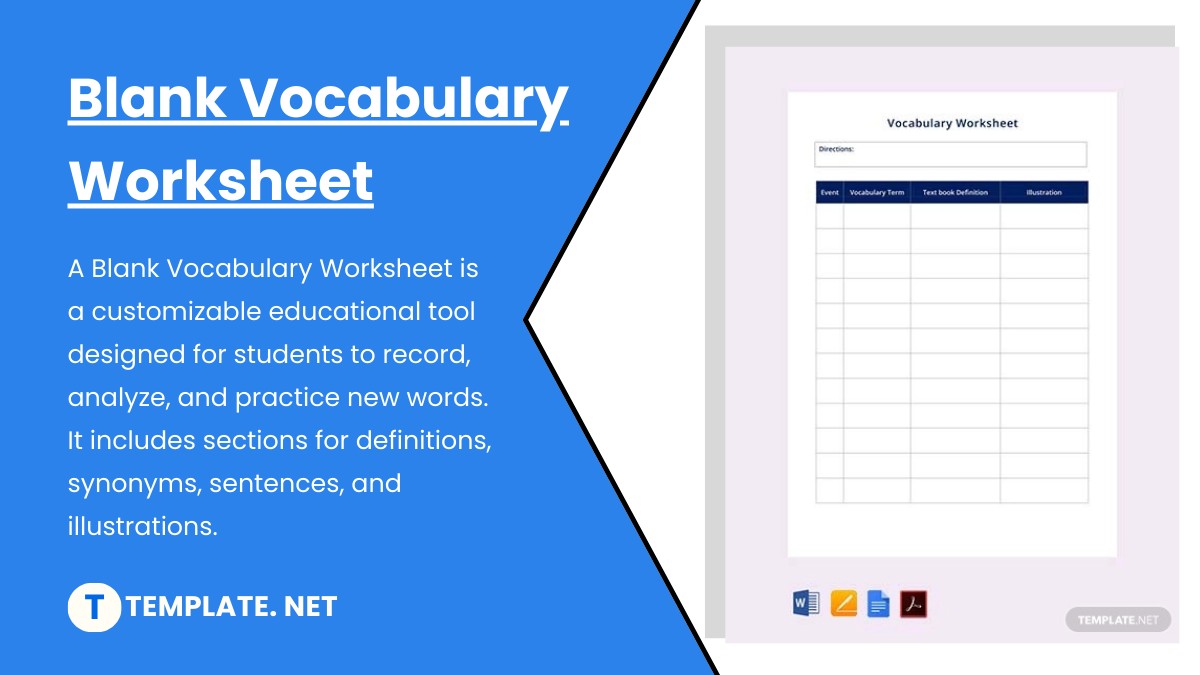Building a strong vocabulary is essential for mastering any language, and English is no exception. Whether you’re a student, teacher, or a lifelong learner, expanding your word knowledge opens doors to better communication, comprehension, and expression. Traditional vocabulary worksheets have long been a staple in language education, but in today’s digital age, leveraging tools like Excel Sheet Template For Learning Vocabulary Words can significantly enhance the learning process.
This article explores how you can use excel sheet template for learning vocabulary words to create a dynamic and effective vocabulary learning system. We’ll delve into the benefits of using Excel, key features to include in your template, and how to maximize its potential for vocabulary acquisition.
Why Choose an Excel Sheet Template for Vocabulary?
While printable worksheets serve their purpose, an excel sheet template for learning vocabulary words offers numerous advantages, particularly in terms of organization, customization, and long-term tracking of your vocabulary journey.
1. Digital Organization and Accessibility
- Centralized Word List: An Excel sheet keeps all your vocabulary words in one easily accessible digital location. No more scattered papers or notebooks.
- Cloud Syncing: With cloud-based Excel services like Google Sheets or Microsoft Excel Online, you can access your vocabulary list from any device, anywhere, anytime. Learn on the go!
2. Customizable and Adaptable Learning
- Tailor-Made Fields: You can customize columns to include exactly what you need for effective learning. Beyond just definitions, consider columns for example sentences, synonyms, antonyms, parts of speech, etymology, or personal notes.
- Dynamic Sorting and Filtering: Excel’s sorting and filtering capabilities are invaluable. Sort words alphabetically, by part of speech, by topic, or even by difficulty level. Filter words you need to review or those related to a specific theme.
3. Enhanced Learning Features
- Formulas and Functions: While it might sound advanced, even simple Excel formulas can boost your learning. Track how many times you’ve reviewed a word, calculate your progress, or even create simple quizzes using formulas.
- Data Visualization: For visual learners, Excel charts can help track your vocabulary growth over time. See your progress and stay motivated!
- Hyperlinking and Multimedia Integration: Link words to online dictionaries, pronunciation guides, or even images and videos for a richer learning experience.
4. Long-Term Progress Tracking
- Record Review Dates: Easily log when you last reviewed a word to implement spaced repetition, a highly effective learning technique.
- Monitor Learning Pace: Track how many new words you’re learning per week or month. This data helps you adjust your learning pace and stay accountable.
Key Components of an Effective Excel Vocabulary Template
To make the most of your excel sheet template for learning vocabulary words, consider incorporating these essential components:
- Word: The vocabulary word itself.
- Definition: The meaning of the word, ideally in your own words for better understanding.
- Example Sentence: A sentence demonstrating the word in context. This is crucial for understanding usage.
- Part of Speech: Noun, verb, adjective, adverb, etc. Understanding grammar is key to using words correctly.
- Synonyms: Words with similar meanings, expanding your vocabulary network.
- Antonyms: Words with opposite meanings, further clarifying the word’s nuances.
- Pronunciation: (Optional) Phonetic transcription or a link to an online pronunciation guide.
- Source: (Optional) Where you encountered the word (book, article, conversation). Context can aid memory.
- Review Date: The date you last reviewed the word.
- Notes: Any personal notes, mnemonics, or associations to help you remember the word.
Creating Your Own Excel Sheet Vocabulary Template: Step-by-Step
Creating your own excel sheet template for learning vocabulary words is straightforward. Here’s a simple guide:
- Open Excel or Google Sheets: Start a new blank spreadsheet.
- Header Row: In the first row, create headers for your columns based on the key components listed above (Word, Definition, Example Sentence, etc.).
- Format Columns: Adjust column widths as needed. Consider using “Wrap Text” for columns like “Definition” and “Example Sentence” to keep content neatly within cells.
- Add Your Vocabulary: Start filling in your vocabulary words and information row by row.
- Customize and Enhance:
- Freeze Panes: Freeze the header row (View > Freeze Panes > Freeze Top Row) so headers are always visible as you scroll down.
- Data Validation: Use data validation (Data > Data Validation) to create dropdown lists for columns like “Part of Speech” for consistency.
- Conditional Formatting: Apply conditional formatting (Home > Conditional Formatting) to highlight words based on review date or other criteria.
- Save Your Template: Save your sheet as a template (.xltx in Excel or use “File” > “Make a copy” in Google Sheets to preserve a blank template).
Maximizing Your Excel Vocabulary Sheet for Effective Learning
Simply having an excel sheet template for learning vocabulary words isn’t enough. Here’s how to use it effectively:
- Regularly Add New Words: Make it a habit to add new words as you encounter them in your reading, listening, or conversations.
- Prioritize Active Recall: Don’t just passively reread definitions. Test yourself! Cover the definition column and try to recall the meaning from just the word.
- Use Spaced Repetition: Review words at increasing intervals. Excel can help you track review dates. Tools like Anki are based on spaced repetition principles and can be integrated with your vocabulary list.
- Focus on Usage: Example sentences are key. Actively try to use new words in your own speaking and writing.
- Make it Personal: Customize your template and learning process to your individual needs and learning style.
Beyond Basic Templates: Advanced Excel Techniques for Vocabulary
For those comfortable with Excel, you can take your excel sheet template for learning vocabulary words to the next level:
- Automated Quizzes: Use formulas to randomly select words from your list and create fill-in-the-blank quizzes.
- Progress Tracking Dashboard: Create charts and graphs to visualize your vocabulary growth, review frequency, and areas needing more attention.
- Integration with Translation APIs: For advanced users, explore using Excel’s Power Query or scripting capabilities to automatically fetch definitions and translations from online APIs.
Conclusion: Excel – Your Powerful Vocabulary Learning Companion
An excel sheet template for learning vocabulary words is more than just a digital worksheet. It’s a powerful, customizable, and dynamic tool that can transform your vocabulary learning experience. By leveraging Excel’s features, you can create a personalized system that fosters organization, active learning, and long-term vocabulary growth. Start building your Excel vocabulary template today and unlock your language learning potential!

